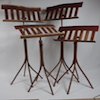And the thing is, in most places, in several months, the relative humidity is different than what it was originally. Unless the wood is going into an environment with an unchanging moisture content (or it is exceptionally thin), it will never equalize to the ambient humidity, because ambient humidity changes before the wood can fully equalize to it.
For example, right now in my house, the relative humidity is around 25%, which is a little high for this time of year. In four months, it could be as high as 80% and even higher in 5-6 months. Last month when it was -30F outside it was probably close to 10%. Around here, wood is never quite the size and shape it really wants to be, so it is basically in constant movement.





 Reply With Quote
Reply With Quote



